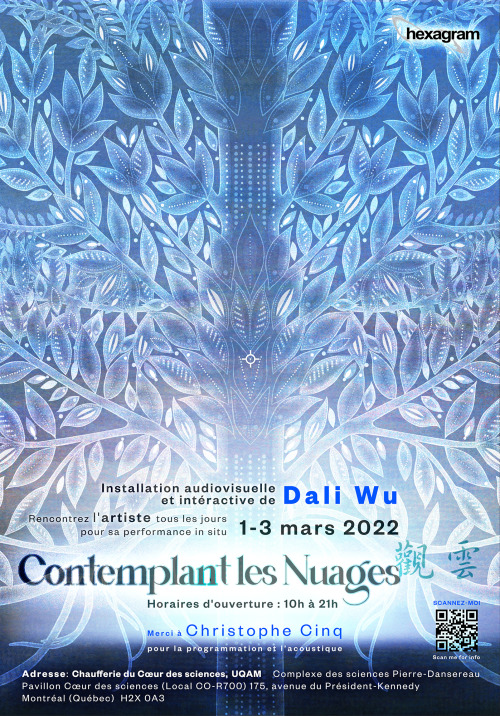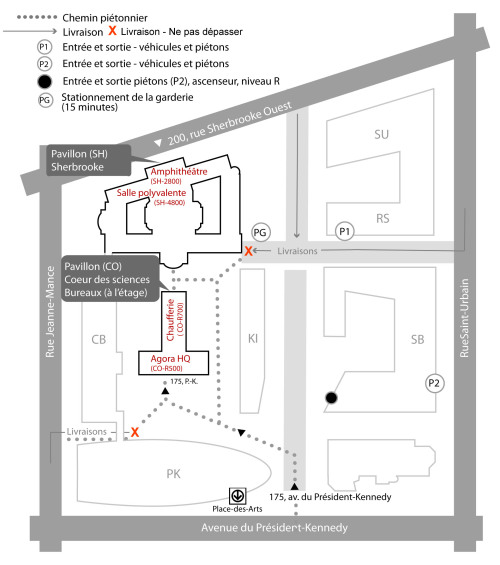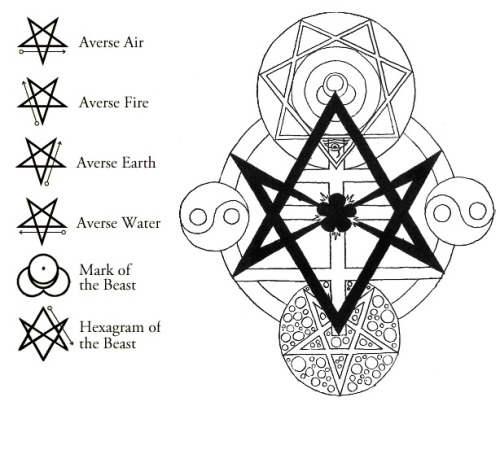#hexagram
Beyond the Enlightenment Rationalists:
From imaginary to probable numbers - VI

(continued from here)
“O Oysters, come and walk with us!” The Walrus did beseech. “A pleasant walk, a pleasant talk, Along the briny beach: We cannot do with more than four, To give a hand to each.”
* * *
“The time has come,” the Walrus said, “To talk of many things: Of shoes–and ships–and sealing-wax– Of cabbages–and kings– And why the sea is boiling hot– And whether pigs have wings.”
-Lewis Carroll, The Walrus and the Carpenter

In this segment, probable numbers will be shown to grow out of a natural context inherently rather than through geometric second thought as transpired in the history of Western thought with imaginary numbers and complex plane. To continue with development of probable numbers it will be necessary to leave behind, for the time being, all preoccupation with imaginary numbers and complex plane. It will also be necessary to depart from our comfort zone of Cartesian spatial coordinate axioms and orientation.
Probable coordinates do not negate validity of Cartesian coordinates but they do relegate them to the status of a special case. In the probable coordinate system the three-dimensional coordinate system of Descartes maps only one eighth of the totality. This means then, that the Cartesian two-dimensional coordinate plane furnishes just one quarter of the total number of corresponding probable coordinate mappings projected to a two-dimensional space.[1] It suggests also that Cartesian localization in 2-space or 3-space is just a small part of the whole story regarding actual spatial and temporal locality and their accompanying physical capacities, say for instance of momentum or mass, but actually encompassing a host of other competencies as well.
Although this might seem strange it is a good thing. Why is it a good thing? First, because nature, as a self-sustaining reality, cannot favor any one coordinate scheme but must encompass all possible - if it is to realize any. Second, because both the Schrödinger equationandFeynman path integral approaches to quantum mechanics say it is so.[2] Third, because Hilbert space demands it. This may leave us disoriented and bewildered, but nature revels in this plan of probable planes. Who are we to argue?
So how do we accomplish this feat? Well, basically by reflections in all dimensions and directions. We extend the Cartesian vectors every way possible. That would give us a 3 x 3 grid or lattice of coordinate systems (the original Cartesian system and eight new grid elements surrounding it), but there are only four different types, so we require only four of the nine to demonstrate. It is best not to show all nine in any case because to do so would place our Cartesian system at direct center of this geometric probable universe and that would be misleading. Why? Because when we tile the two-dimensional universe to infinity in all directions, there is no central coordinate system. Any one of the four could be considered at the center, so none actually is. Overall orientation is nondiscriminative.[3]
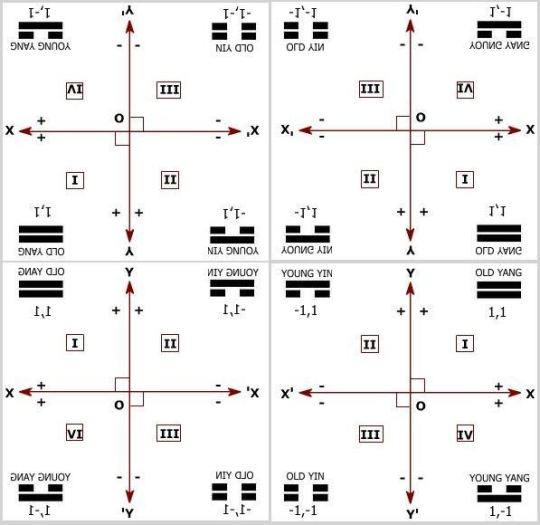
LOOKING GLASS CARTESIAN COORDINATE QUARTET
The image seen immediately above shows four Looking House Cartesian coordinate systems, correlated within a mandalic plane. This mandalic plane is one of six faces of a mandalic cube, each of which is constructed to a different plan but composed of similar building blocks, the four bigrams in various positions and orientations. A 2-dimensional geometric universe can be tiled with this image, recursively repeating it in all directions throughout the two dimensions.[4] It should not be very difficult for the reader to determine which of the four mandalic moieties references our particular conventional Cartesian geometric universe.[5]

It remains only to be added here and now that potential dimensions, probable planes, and probable numbers arise immediately and directly from the remarks above. In some ways it’s a little like valence in chemical reactions. We’ll likely take a look at that combinatory dynamic in context of mandalic geometry at some time down the road. Next though we want to see how the addition of composite dimension impacts and modifies the basic geometry of the probable plane discussed here.[6]
(to be continued)
Top image: The four quadrants of the Cartesian plane. These are numbered in the counterclockwise direction by convention. Architectonically, two number lines are placed together, one going left-right and the other going up-down to provide context for the two-dimensional plane. This image has been modified from one found here.
Notes
[1] To clarify further: There are eight possible Cartesian-like orientation variants in mandalic space arranged around a single point at which they are all tangent to one another. If we consider just the planar aspects of mandalic space, there are four possible Cartesian-like orientation variants which are organized about a central shared point in a manner similar to how quadrants are symmetrically arranged about the Cartesian origin point (0,0) in ordinary 2D space. But here the center point determining symmetries is always one of the points showing greatest rather than least differentiation. That is to say it is formed by Cartesian vertices, ordered pairs having all 1s, no zeros. That may have confused more than clarified, but it seemed important to say. We will be expanding on these thoughts in posts to come. Don’t despair. For just now the important takeaway is that the mandalic coordinate system combines two very important elements that optimize it for quantum application: it manages to be both probabilistic and convention-free (in terms of spatial orientation, which surely must relate to quantum states and numbers in some as yet undetermined manner.) At the same time, imaginary numbers and complex plane are neither.
[2] Even if physics doesn’t yet (circa 2016) realize this to be true.
[3] It is an easy enough matter to extrapolate this mentally to encompass the Cartesian three-dimensional coordinate system but somewhat difficult to demonstrate in two dimensions. So we’ll persevere with a two-dimensional exposition for the time being. It only needs to be clarified here that the three-dimensional realization involves a 3 x 3 x 3 grid but requires just eight cubes to demonstrate because there are only eight different coordinate system types.
[4] I am speaking here in terms of ordinary dimensions but it should be understood that the reality is that the mandalic plane is a composite 4D/2D geometric structure, and the mandalic cube is a composite 6D/3D structure. The image seen here does not fully clarify that because it does not yet take into account composite dimension nor place the bigrams in holistic context within tetragrams and hexagrams. All that is still to come. Greater context will make clear how composite dimension works and why it makes eminent good sense for a self-organizing universe to invoke it. Hint: it has to do with quantum interference phenomena and is what makes all process possible.
ADDENDUM (12 APRIL, 2016)
The mandalic plane I am referring to here corresponds to the Cartesian 2-dimensional plane and is based on four extraordinary dimensions that are composited to the ordinary two dimensions, hence hybrid 4D/2D. It should be understood though that any number of extra dimensions could potentially be composited to two or three ordinary dimensions. The probable plane described in this post is not such a mandalic plane as no compositing of dimensions has yet been performed. What is illustrated here is an ordinary 2-dimensional plane that has undergone reflections in x- and y-dimensions of first and second order to form a noncomposited probable plane. The distinction is an important one.
[5] This is perhaps a good place to mention that the six planar faces of the mandalic cube fit together seamlessly in 3-space, all mediated by the common shared central point, in Cartesian terms the origin at ordered triad (0.0.0) where eight hexagrams coexist in mandalic space. Moreover the six planes fit together mutually by means of a nuclear particle-and-force equivalent of the mortise and tenon joint but in six dimensions rather than two or three, and both positive and negative directions for each.
[6] It should also be avowed that tessellation of a geometric universe with a nondiscriminative, convention-free coordinate system need not exclude use of Cartesian coordinates entirely in all contextual usages. Where useful they can still be applied in combination with mandalic coordinates since the two can be made commensurate, irrespective of specific Cartesian coordinate orientation locally operative. Whatever the Cartesian orientation might be it can always be overlaid with our conventional version of the same. More concretely, hexagram Lines can be annotated with an ordinal numerical subscript specifying Cartesian location in terms of our local convention should it prove necessary or desirable to do so for whatever reason.
On the other hand, before prematurely throwing out the baby with the bath water, we might do well to ask ourselves whether these strange juxtapositions of coordinates might not in fact encode the long sought-after hidden variables that could transform quantum mechanics into a complete theory. In mandalic coordinates of the reflexive nature described, these so-called hidden variables could be hiding in plain sight. Were that to prove the case, David Bohm andLouis de Broglie would be immediately and hugely vindicated in advancing their pilot-wave theory of quantum mechanics. We could finally consign the Copenhagen Interpretation to the scrapheap where it belongs, along with both imaginary numbers and the complex plane.
ADDENDUM (24 APRIL, 2016)
Since writing this I’ve learned that de Broglie disavowed Bohm’s pilot wave theory upon learning of it in 1952. Bohm had derived his interpretation of QM from de Broglie’s original interpretation but de Broglie himself subsequently converted to Niels Bohr’s prevailing Copenhagen interpretation.
© 2016 Martin Hauser
Please note: The content and/or format of this post may not be in finalized form. Reblog as a TEXT post will contain this caveat alerting readers to refer to the current version in the source blog. A LINK post will itself do the same. :)
Scroll to bottom for links to Previous / Next pages (if existent). This blog builds on what came before so the best way to follow it is chronologically. Tumblr doesn’t make that easy to do. Since the most recent page is reckoned as Page 1 the number of the actual Page 1 continually changes as new posts are added. To determine the number currently needed to locate Page 1 go to the most recent post which is here. The current total number of pages in the blog will be found at the bottom. The true Page 1 can be reached by changing the web address mandalicgeometry.tumblr.com to mandalicgeometry.tumblr.com/page/x, exchanging my current page number for x and entering. To find a different true page(p) subtract p from x+1 to get the number(n) to use. Place n in the URL instead of x (mandalicgeometry.tumblr.com/page/n) where
n = x + 1 - p. :)
-Page 311-
Beyond Taoism - Part 5
A Vector-based Probabilistic
Number System
Part II

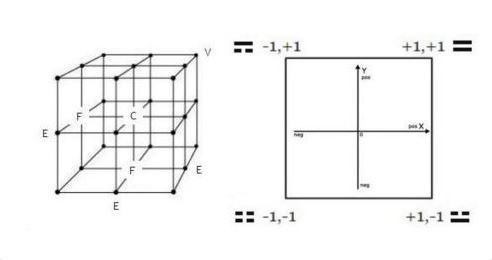
(continued from here)
Taoism and the primordial I Chingare in agreement that temporal changes have two different aspects: sequent and cyclic. Western thought in general follows suit. The I Ching differs from the other two in asserting that the direction of change - for both sequent and cyclic change - is fully reversible, with the proviso that sufficiently small units of measurement are involved.[1] The probability that reversal can be achieved diminishes proportionately to the magnitude of change that has taken place.[2]
Taoist appropriation of bigrams and trigrams of the I Ching to model such phenomena as change of seasons and phases of the moon is plausible if not quite legitimate. The natural phenomena so modeled are macroscopic and vary continuouslyandinexorably throughout an ever-repeating cyclic spectrum. And there’s the rub.

As they occur and function in the I Ching bigrams and trigrams are dicontinuous discrete elements, formed by other similarly discontinuous discretized entities, and they follow evolutionary courses which are most often nonrepetitive. So the Taoist usage is misleading at best, annihilative at worst. Unfortunately, as the I Ching itself evolved through centuries of commentaries and reinterpretations, it became ever more contaminated and tainted by these Taoist corruptions of meaning, at the same time that it was being inundated by Confucian sociological and ethical reworkings. What we have today is an amalgam, the various parts of which do not sit well with one another.[3]
Though it may in part be hyperbole to prove a point, the stark difference between the two approaches, that of Taoism and that of the I Ching, is epitomized by comparison of the Taoist diagram of the cycle of seasons with diagrams at the top and bottom of the page, which are based on the number, logic, and coordinate systems of The Book of Changes.[4] The increased complexity of the latter diagrams should not prove a stumbling block, as they can be readily understood in time with focus and attention to detail. The important take-away for now is that in the I Ching bigrams exist within a larger dimensional context than the Taoist diagram avows, and this context makes all their interactions more variable, conditional, and complex. As well, the same can be said of trigrams and hexagrams.
One of the more important aspects of these differences has to do with the notion of equipotentiality. As bigrams and trigrams function within higher dimensional contexts in the I Ching, this introduces a possibility of multiple alternative paths of movement and directions of change. Put another way, primordial I Ching logic encompasses many more degrees of freedom than does the logic of Taoism.[5] There is no one direction or path invariably decreed or favored. An all-important element of conditionality prevails. And that might be the origin of what quantum mechanics has interpreted as indeterminism or chance.
Next up, a closer look at equipotentiality and its further implications.
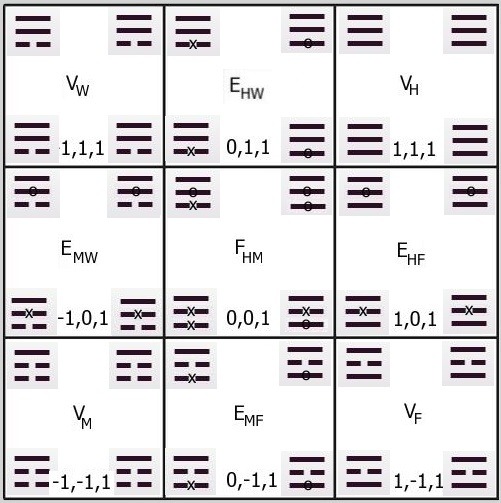
Section FH(n)[6]
(continuedhere)
Notes
[1] There are exceptions. Taoist alchemy describes existence of certain changes that admit reversibility under special circumstances. Other than the Second Law of Thermodynamics (which is macroscopic in origin, not result of any internally irreversible microscopic properties of the bodies), the laws of physics neglect all distinction between forward-moving timeandbackward-moving time. Chemistry recognizes existence of certain states of equilibrium in which the rates of change in both directions are equal. Other exceptions likely occur as well.
[2] Since change is quantized in the I Ching, which is to say, it is divided into small discretized units, which Line changes model, the magnitude of change is determined by the number of Line changes that have occurred between Point A and Point B in spacetime. Reversal is far easier to achieve if only a single Line change has occurred than if three or four Lines have changed for example.
[3] Ironically, Taoism itself has pointed out the perils of popularity. Had the I Ching been less popular, less appealing to members of all strata of society, it would have traveled through time more intact. Unless, of course, it ended up buried or burned. What is fortunate here is that much of the primordial logic of the I Ching can be reconstructed by focusing our attention on the diagrammatic figures and ignoring most of the attached commentary.
[4] These diagrams do not occur explicitly in the I Ching. The logic they are based on, though, is fully present implicitly in the diagramatic structural forms of hexagrams, trigrams, and bigrams and the manner of their usage in I Ching divinatory practices.
[5] Or, for that matter, than does the logic of Cartesian coordinate space if we take into account the degrees of freedom of six dimensional hexagrams mapped by composite dimensional methodology to model mandalic space. (See Note [4] here for important related remarks.)
[6] This is the closest frontal section to the viewer through the 3-dimensional cube using Taoist notation. See here for further explanation. Keep in mind this graph barely hints at the complexity of relationships found in the 6-dimensional hypercube which has in total 4096 distinct changing and unchanging hexagrams in contrast to the 16 changing and unchanging trigrams we see here. Though this model may be simple by comparison, it will nevertheless serve us well as a key to deciphering the number system on which I Ching logic is based as well as the structure and context of the geometric line that can be derived by application of reductionist thought to the associated mandalic coordinate system of the I Ching hexagrams. We will refer back to this figure for that purpose in the near future.
© 2016 Martin Hauser
Please note: The content and/or format of this post may not be in finalized form. Reblog as a TEXT post will contain this caveat alerting readers to refer to the current version in the source blog. A LINK post will itself do the same. :)
Scroll to bottom for links to Previous / Next pages (if existent). This blog builds on what came before so the best way to follow it is chronologically. Tumblr doesn’t make that easy to do. Since the most recent page is reckoned as Page 1 the number of the actual Page 1 continually changes as new posts are added. To determine the number currently needed to locate Page 1 go to the most recent post which is here. The current total number of pages in the blog will be found at the bottom. The true Page 1 can be reached by changing the web address mandalicgeometry.tumblr.com to mandalicgeometry.tumblr.com/page/x, exchanging my current page number for x and entering. To find a different true page(p) subtract p from x+1 to get the number(n) to use. Place n in the URL instead of x (mandalicgeometry.tumblr.com/page/n) where
n = x + 1 - p. :)
-Page 300-
Quantum Naughts and Crosses Revisited - II


(continued from here)
This post builds on orientational material offered in the previous post. An explanation of the procedural method of graphic demonstration used in this post and those following can be found there, and it would be helpful to review that earlier post, if not already done, before proceeding further.
Due in part to the challenging subject matter, in part to arduous graphic demonstration, we’ll approach this investigation in three stages of progressive difficulty. In the first stage we’ll just dangle our feet in the water by looking at how the "slicing methodology" works with ordinary three-dimensional Cartesian coordinates. In the second stage, we’ll go waist-deep, and consider the same Cartesian coordinates in their Taoist notation transliteration equivalents. And in the final stage, we’ll go for full immersion, with graphic representation of true mandalic geometry, that is, plotting all 64 hexagrams in a hybrid 6D/3D coordinate system using the methodology of composite dimension which, of course, has no analogue in purely Cartesian terms.
At each stage - Cartesian, Taoist transliteration, and mandalic - we’ll look at the respective cube in frontal,transverse, and sagittal slices, always in that order and always progressing from identity face containing Cartesian (1,1,1), trigram HEAVEN, or hexagram HEAVEN to inversion face, containing Cartesian (-1,-1,-1), trigram EARTH, or hexagram Earth, as the case may be.
To accomplish our purpose we will require an effective, consistent way to refer to the individual “slices” and each of the 27 Cartesian points. There are three “slices” for each type of sectioning of the “cube”, so a total of nine. I propose that we uniquely identify each “slice” by labeling it with the first letter of the section type (frontal, transverse, or sagittal) and the subscript letters “H” for planes containing trigram or hexagram HEAVEN but not Earth, “E” for planes containing trigram or hexagram EARTH but not HEAVEN, and “HE” for planes containing both trigram forms.[1]
The labels of the sections, then, will be:
- FH frontal section containing HEAVEN but not EARTH
- FHE frontal section containing both HEAVEN and EARTH
- FE frontal section containing EARTH but not HEAVEN
- TH transverse section containing HEAVEN but not EARTH
- THE transverse section containing both HEAVEN and EARTH
- TE transverse section containing EARTH but not HEAVEN
- SH sagittal section containing HEAVEN but not EARTH
- SHE sagittal section containing both HEAVEN and EARTH
- SE sagittal section containing EARTH but not HEAVEN
For the 27 individual discretized Cartesian points, I propose the following labeling convention:
Each point is to be first identified as to type. There are four point types: vertex(V), edge center(E), face center(F), and cube center(O). The cube center corresponds to the Cartesian triad (0,0,0), the origin point of the Cartesian coordinate system. In the Cartesian/Euclidean cube there are 8 vertices, 12 edge centers, 6 face centers, and a single cube center. The higher dimensional mandalic cube has many more of each of these.
Vertices
Having identified the point type, each point is then further identified by a subscript consisting of the first letter of the name of trigram or hexagram that is resident at the point. The single exception to this will be WATER. To differentiate between WATER and WIND, I propose using the letter “A” (first letter of “aqua”, Latin for “water”) to specify WATER. This plan allows us, then, to discriminate among the various vertex points, and also to distinguish them from the other point types. Accordingly, we arrive at these labels for the 8 vertex points:
- VH HEAVEN
- VE EARTH
- VT THUNDER
- VW WIND
- VA WATER
- VF FIRE
- VM MOUNTAIN
- VL LAKE
Edge centers
Edge centers will be labeled “E” along with a subscript consisting of the first letter of its two vertices, “A” being used instead of “W” for WATER. Though this may initially seem excessively complicated, the reasons for setting things up this way will soon be made clear, and it will all become second nature. The 12 edge centers will be labeled as below:
- EHW
- EHF
- EHL
- EET
- EEA
- EEM
- ETF
- ETL
- EAW
- EAL
- EMW
- EMF
Face centers
There are six face centers. Three occur in identity faces of the cube that contain the trigram or hexagram HEAVEN; three, in inversion faces that contain the trigram or hexagram EARTH. Labeling will be with the letter “F” and a subscript consisting of either “E” for EARTH along with one of its companion diagonal vertices, “W” for WIND, “F”, FIRE, “L”, LAKE or “H” for HEAVEN, along with one of its companion diagonal vertices, “T” for THUNDER, “A”, WATER, “M”, MOUNTAIN. So these six face center labels are:
- FEW
- FEF
- FEL
- FHT
- FHA
- FHM
Cube center
The cube center, which is singular in Cartesian terms but a multiple composite in terms of mandalic geometry, will be labeled as:
- O
identifying it as the origin of the coordinate system, that is to say, of both the Cartesian coordinate system and the mandalic coordinate system.
With that, let the games begin!
(continuedhere)
Notes
[1] There are no sections among those described that include both the hexagram HEAVEN and the hexagram EARTH.
© 2015 Martin Hauser
Please note: The content and/or format of this post may not be in finalized form. Reblog as a TEXT post will contain this caveat alerting readers to refer to the current version in the source blog. A LINK post will itself do the same. :)
Scroll to bottom for links to Previous / Next pages (if existent). This blog builds on what came before so the best way to follow it is chronologically. Tumblr doesn’t make that easy to do. Since the most recent page is reckoned as Page 1 the number of the actual Page 1 continually changes as new posts are added. To determine the number currently needed to locate Page 1 go to the most recent post which is here. The current total number of pages in the blog will be found at the bottom. The true Page 1 can be reached by changing the web address mandalicgeometry.tumblr.com to mandalicgeometry.tumblr.com/page/x, exchanging my current page number for x and entering. To find a different true page(p) subtract p from x+1 to get the number(n) to use. Place n in the URL instead of x (mandalicgeometry.tumblr.com/page/n) where
n = x + 1 - p. :)
-Page 287-
Quantum Naughts and Crosses Revisited - I

(continued from here)
Because nature is ever playful, grokking mandalic geometry is much like a game. We view it as a largely serious one, though, one that involves combinatorics, Boolean logic, and magic squares and cubes. Groundwork for what appears in this post, and several to follow, was laid in May, 2014 in a series titled “Quantum Naughts and Crosses” which began here.
The game is played on a board or field made of three-dimensional coordinates of the Cartesian variety upon which are superimposed the six additional extraordinary dimensions unique to mandalic coordinates. For convenience and ease of representation, the board will be displayed here in two dimensional sections abstracted from the Cartesian cube and from the superimposed mandalic hypercube in a manner analogous to the way computed tomography renders sections of the human body.
The sections commonly used[1] in computed tomographyandmagnetic resonance imaging (MRI) are
- Frontal
- Transverse
- Sagittal
For our purposes here, these can be thought of as
- Planes perpendicular to the z-axis viewed from front to back of cube
- Planes perpendicular to the y-axis viewed from top to bottom of cube
- Planes perpendicular to the x-axis viewed from side right to left of cube
These “cuts” will produce square sections through xy-, xz-, and yz-planes, respectively, of the Cartesian cube and, in the case of the mandalic cube, analogous sections of higher dimension.
These choices of sections are made largely for convenience and ease of communicability. They are mainly of a conventional nature.[2] On the other hand, there is special significance in the fact that all three section types progress from identity faces of the cube, containing the trigram or hexagram HEAVEN, to inversion faces, containing trigram or hexagram EARTH. Some manner of consistency of this sort is necessary. The one chosen here will make things easier as we progress.
Ourgameboard has 27 discretized Cartesian points, centered in 3 amplitude levels about the Cartesian origin (0,0,0).[3] Each point in the figure on the right above is represented by a single small cube, but in the two-dimensional sections we’ll be using for elaboration, they will appear as small squares. So the gameboard is “composed of” 27 cubes arranged in a 3x3x3 pattern. But in descriptions of sections, we will view 9 squares in a 3x3 pattern. This configuration will appear as

But keep in mind each small square in this figure is actually a small cube representing one of the 27 discretized Cartesian points we’ve described.
Until next time, then.
(continuedhere)
Notes
[1] The origin of the word "tomography" is from the Greek word “tomos” meaning “slice” or “section” and “graphe” meaning “drawing.” A CT imaging system produces cross-sectional images or “slices” of anatomy, like the slices in a loaf of bread. The “slices” made are transverse (cross-sections from head to toes or, more often, a portion thereof), but reconstructions of the other types of sections described above are sometimes made, and MRI generates all three types natively.
[2] Admittedly, I’ve chosen the convention here myself and to date it is shared by no one else. Perhaps at some future time it will be a shared convention. One can only hope.
[3] These three discrete amplitude levels of potentiality in the mandalic 9-cube correspond geometrically to face centers, edge centers and vertices of the 3-cube of Cartesian coordinates. They are encoded by the six new potential dimensions interacting with the three ordinary Cartesian dimensions in context of the hybrid 6D/3D mandalic cube. They are a feature of the manner of interaction of all nine temporospatial dimensions acting together in holistic fashion. This should begin to give an idea why there is no Taoist line that can generate a 9-cube in a fashion analogous to the way the Western number line is used to generate the Cartesian / Euclidean 3-cube. The 9-dimensional entity is primeval and a variety of different types of "line" can be derived from it. Similarly, the mandala of the I Ching hexagrams cannot be derived from the logic encoded in any linear structure. An overarching perspective is required to derive first the mandala of hexagrams and then from it, a variety of Taoist line types. Nature may be playful, but it is not nearly as simplistic as our Western science, mathematics, and philosophy would have it.
© 2015 Martin Hauser
Please note: The content and/or format of this post may not be in finalized form. Reblog as a TEXT post will contain this caveat alerting readers to refer to the current version in the source blog. A LINK post will itself do the same. :)
Scroll to bottom for links to Previous / Next pages (if existent). This blog builds on what came before so the best way to follow it is chronologically. Tumblr doesn’t make that easy to do. Since the most recent page is reckoned as Page 1 the number of the actual Page 1 continually changes as new posts are added. To determine the number currently needed to locate Page 1 go to the most recent post which is here. The current total number of pages in the blog will be found at the bottom. The true Page 1 can be reached by changing the web address mandalicgeometry.tumblr.com to mandalicgeometry.tumblr.com/page/x, exchanging my current page number for x and entering. To find a different true page(p) subtract p from x+1 to get the number(n) to use. Place n in the URL instead of x (mandalicgeometry.tumblr.com/page/n) where
n = x + 1 - p. :)
-Page 286-
Beyond Descartes - Part 7
Composite Dimension and
Amplitudes of Potentiality
Episode 1


(continued from here)
Having frightened away all the cognitive wusses with my remark in that last post about the complexity of composite dimension and of the mandalic coordinate system based on it, I have a confession to make to those followers who remain. Although understanding the ideas involved requires a step back and viewing them from a different perspective alien to our Western modes of thought, composite dimension and the plane of potentiality are at once more natural and far less complicated than are imaginary numbers and the complex plane. Stay with me here. There is a light at the end of the tunnel growing ever brighter.
The 6D/3D mandalic cube is a hybrid structure having four levels of amplitude potentiality represented geometrically by 27 3D points which correspond to Cartesian points centered about Cartesian (0,0,0) and 64 6D points, corresponding to the 64 hexagrams, similarly centered and distributed among the 27 Cartesian points in such a way as to create a probability distribution through all three Cartesian dimensions, that is with geometric progression of the number of hexagrams resident in the different amplitudes or orbitals. This gives rise to the mandalic form of the coordinate system. There are four well-defined orbitals or shells in this unique geometric arrangement of hexagrams and, parenthetically, whatever it is they represent in physical terms.[1]
We can conceptually abstract and decompose the 3D moiety of this concept entity, the part corresponding to Cartesian space. In doing so we identify a cube having a single center and eight vertices, all points by Euclidean/Cartesian reckoning, twelve edges (lines), each having an edge center (points), and six faces (planes), each having a center (point) equidistant from its four vertices. Each vertex point is shared equally by three faces or planes of the cube and each edge, by two adjacent faces or planes. We have previously analyzed in detail how the six planes of the 3D cube dovetail with one another and the repercussions involved. (See hereandhere.) One of the most important consequences we find is that each face center coordinates in a special way all four vertices of the face. This becomes particularly significant in consideration of the composite dimension-derived hypercube faces of mandalic geometry.
The 6D moiety follows an analogous but more complex plan and has been formulated so as to be commensurate with the convention of the Cartesian coordinate system. It also introduces measurement of a discretized time to the coordinates, thus rendering the geometry one of spacetime. The hybrid 6D/3D configuration introduces probability as well through its bell curve/normal distribution (1, 2) of hexagrams; and also, the two new directions, manifestation (differentiation) and potentialization (dedifferentiation).[2] These unfamiliar directions are unique to mandalic geometry and the I Ching upon which it is based.
In the lower diagram above, the figure on the right represents the skeletal structure of the hybrid 6D/3D coordinate system; the figure on the left, the skeletal structure of the corresponding 3D Cartesian moiety. The 27 discretized points of the cube on the left have become 64 points of the 6D hypercube on the right. In the next post we will begin to flesh these two skeletons out.[3] The end results are nothing short of amazing.
(continuedhere)
Notes
[1] With this remark I am avowing that mandalic geometry is intended not just as an abstract pure mathematical formulation, but rather as a logical/geometrical mapping of energetic relationships that exist at some scale of subatomic physics, Planck scale or other. I maintain the possibility that this is so despite the obvious and unfortunate truth that we cannot now ascertain just what it is the hexagrams represent, and may, in fact, never be able to.
[2] Manifestation/differentiation corresponds to the direction of divergence; potentialization/dedifferentiation, to the direction of convergence. The former is motion away from a center; the latter, motion toward a center. Convergenceanddivergence are the two directions found in every Taoist line that do not occur in Cartesian space, at least not explicitly as such. There are functions in Cartesian geometry that converge toward zero as a limit. To reach zero in Cartesian space however is to become ineffective. That is quite different from gaining increased potential, potential which can then be used subsequently in new differentiations. (See also the series of posts beginning here.) Both the terms differentiationanddedifferentiation were brazenly borrowed from the field of biology, while the designations manifestandunmanifest have been shamelessly appropriated from Kantian philosophy, though similar concepts also occur in different terminology in deBroglie-Bohmian pilot-wave theoryasexplicitandimplicit.
[3] In the figure of the cube on the lower left above there is a single Cartesian triad (point) identifying each vertex (V), edge center (E), face center (F), and cube center C. In the right figure, the hybrid 6D/3D hypercube at each vertex has one resident hexagram identifying it, two resident hexagrams at each edge center, four resident hexagrams identifying each face center, and eight resident hexagrams identifying the hypercube center. This brings the total of hexagrams to 64, the number found in the I Ching and the total possible number (26 = 64). This geometric progression of hexagram distribution, through three Cartesian dimensions constitutes the mandalic form. It is entirely the result of composite dimension.
© 2015 Martin Hauser
Please note: The content and/or format of this post may not be in finalized form. Reblog as a TEXT post will contain this caveat alerting readers to refer to the current version in the source blog. A LINK post will itself do the same. :)
Scroll to bottom for links to Previous / Next pages (if existent). This blog builds on what came before so the best way to follow it is chronologically. Tumblr doesn’t make that easy to do. Since the most recent page is reckoned as Page 1 the number of the actual Page 1 continually changes as new posts are added. To determine the number currently needed to locate Page 1 go to the most recent post which is here. The current total number of pages in the blog will be found at the bottom. The true Page 1 can be reached by changing the web address mandalicgeometry.tumblr.com to mandalicgeometry.tumblr.com/page/x, exchanging my current page number for x and entering. To find a different true page(p) subtract p from x+1 to get the number(n) to use. Place n in the URL instead of x (mandalicgeometry.tumblr.com/page/n) where
n = x + 1 - p. :)
-Page 283-
Invitation : l’Exposition d’une installation audiovisuelle et interactive « Contemplant les Nuages » à Hexagram - UQAM
Invitation of an audiovisual and interactive installation “Contemplating Clouds” exhibition at Hexagram - UQAM
1-3 mars 2022/March 1-3, 2022
Horaire d’ouverture : 10h à 21 h
Rencontrez l’artiste tous les jours pour sa performance in situ
Opening hours: 10 a.m. to 9 p.m.
Meet the artist every day for her in situ performance
Adresse/Address : Chaufferie du Cœur des sciences
Complexe des sciences Pierre-Dansereau
Pavillon Cœur des sciences (Local CO-R700)
175, avenue du Président-Kennedy
Montréal (Québec) H2X 0A3 QC, CANADA
Description en Français(English is below)
Note de synthèse du projet :
Parmi toutes les choses dans la nature, le nuage semble être le plus insaisissable. Il peut générer innombrables formes, tout comme la diversité et l’inconstance des phénomènes. Il change constamment, comme si un groupe d’entités peut disparaitre soudainement, sans laisser aucune trace. Par conséquent, la contemplation des nuages coulant haut et bas, se transformant, s’étendant et se rétrécissant à leur propre rythme, nous permet de saisir plus directement la nature de la myriade de phénomènes.
Le nuage est également le meilleur symbole de la vacuité de nature propre de tous les phénomènes conditionnés ou inconditionnés. Il aussi illustre la non-dualité — comme la vacuité relative est l’absence de substrat permanent des phénomènes, tandis que la vacuité absolue désigne la même absence de substance dans l’Absolu (Nirvana, ou la Grande Libération) lui même, « là où il n’y a rien, où rien ne peut être saisi » (Sutta Nipata). Il n’y a donc pas de dualité entre relatif et absolu, le terme de vacuité désignant la même réalité vue sous deux angles.
Notre pensée est un grand créateur qui peut dessiner des myriades de choses, et toutes choses qui sont créées par notre pensée ont un point commun : la vacuité de substance. C’est par cette nature, les choses — des matières et des idées, peuvent se transformer et changer, c’est-à-dire « trans-» ; aussi par cette nature, Creatio ex nihilo, on peut se transcender en transcendant les conventions et les conditions.
À travers ce projet «Contemplant les Nuages», j’aimerais inviter l’audience à témoigner de la nature illusoire de la réalité, c’est-à-dire « apparemment être, substantiellement inexister » — la non-dualité de la vacuité et de l’existence.
Le processus de création du dispositif interactif :
Du 25 avril 2021 jusqu’à présent, je saisis le paysage nuageux occidental tous les jours à un moment précis depuis le toit de mon appartement avec les pastels secs et techniques mixtes. L’heure de l’enregistrement de chaque dessin variait de 18 h à 21 h. Ce projet d’un an devrait se terminer le 24 avril 2022.
Durant ce processus, je me considère simplement comme un système biométrique. Je choisis d’enregistrer par esquisses, car la conscience subjective individuelle à travers cette technique est plus révélatrice, et le dessin en tant que véhicule peut capturer plus directement les différents états d’esprit de l’humain. Non seulement les paysages changeants des nuages, mais aussi la mentalité différente de l’artiste qui est unique à la situation et à l’environnement spécifiques de chaque moment différent, seront également enregistrés; la plupart des enregistrements portent sur le coucher du soleil, car l’air du soir est le plus épais, et les changements de nuages dans le ciel sont les plus divers. En même temps, le soleil en ce moment se prépare à se coucher, comme s’il revenait enfin sur terre, tout comme la scène de la fin de la vie.
Conception de l’installation sur scène:
En termes de la présentation, j’ai choisi le paravent pour incarner le projet.



Ce sera une installation interactive et audiovisuelle.
Dans les temps anciens, la fonction du paravent était de rendre les gens calmes, reposants et stables, et avait pour effet d’espacer et de bloquer le vent. Le vent se prononce rLung en tibétain (tibétain : རླུང) ce qui signifie aussi respirer. C'est un concept clé dans les traditions vajrayana du bouddhisme tibétain et il y a une variété de significations. La fonction générale de rLung est d'aider la croissance, le mouvement du corps, l'expiration et l'inspiration et d'aider la fonction de l'esprit, de la parole et du corps. Ici, le paravent transparent joue non seulement le rôle de blindage et d'isolation du vent/rLung, mais joue également le rôle de révélateur.
Note d’intention et problématique de recherche :
Comment l’utilisation des technologies dans un processus de recherche-création peut-elle conduire à la création d’un corpus d’œuvres qui fait vivre une expérience de l’intersubjectivité transcendantale?
Theodor W. Adorno à son retour de l’exil américain en 1949, il écrivit : «Écrire un poème après Auschwitz est barbare» (Prismes, Critique de la culture et société, p. 26). Quand Adorno déclare la poésie impossible (ou plutôt barbare) après Auschwitz, c’est parce que l’impossibilité est une impossibilité habilitante : la poésie est toujours, par définition, «à propos» de quelque chose qui ne peut pas être adressé directement, il ne peut seulement faire allusion. (Žižek, 2008)
Au total, cela signifie que si nous ne pouvons pas faire face au cœur de la douleur et des ténèbres, nous serons nous-mêmes barbares. Et toutes les grandes littératures, poésies et créations artistiques doivent affronter le cœur de l’obscurité de la douleur. Et le langage esthétique hautement unifié et assimilé, qu’il soit politique, commercial ou technologique, est difficile pour le créatrice ou créateur à saisir en son cœur, plus difficile à saisir ces souffrances individuelles. Il faut donc recréer un langage, comme l’a fait Paul Celan dans son «Fugue de la mort».
Les artistes allemands, dont Anselm Kiefer, ont regardé cette question en face. Comment, pour un Allemand, faire de l’art après Hitler, après que les nazis aient prétendu mettre l’art au service de leurs crimes?
Je pose la même question en tant que telle, une jeune artiste comme moi originaire de Chine continentale, je contemple qu’en Chine aujourd’hui, l’art et la culture contemporains soient considérés plus ou moins comme la décoration de l’empire.
Je comprends donc que chaque expression d’un individu est une réécriture de la certitude, comme elle est essentiellement artistique, et chaque expression d’un individu est aussi une intervention idéologique. Pour moi, les pratiques de l’art contemporain sont des murmures de rédemption. En utilisant un vocabulaire universel — images, couleurs, et synesthésie, j’aimerais que mes œuvres de narration picturale soient accessibles à tous, femme et homme, quels que soient leurs âges, leurs origines et leur éducation.
Citons un célèbre dicton de Carl Jung, «Là où l’amour règne, il n’y a pas volonté de puissance et là où domine la puissance, manque l’amour. L’un est l’ombre de l’autre», ce n’est que lorsque l’amour existe que le dialogue peut naître, que l’intersubjectivité peut être comprise, que la création artistique peut stimuler le sens subjectif de l’esthétique sous un certain angle transcendantale et qu’une œuvre d’art peut être qualifiée d’œuvre d’art. Le mot «amour» ici, est peut-être plus proche d’«empathie». Rudolph Vischer (1873/1994) a inventé le terme «einfühlung», qui est devenu plus tard l’«empathie», dans sa thèse doctorale «On the Optical Sense of Form: A Contribution to Aesthetics», il a explicitement lié l’empathie à l’expérience esthétique de la forme, en la décrivant comme une projection corporelle sur la forme observée ou l’Autre, une projection rendue possible par un «amour naturel pour [son] espèce» (p. 103) même lorsqu’elle est dirigée vers une forme non vivante.
Et la description de l’empathie de Buber (1947/2002) est «glid[ing] with one’s own feeling into the dynamic structure of an object [and] … trac[ing] it from within» (p. 115) correspond étroitement à la description de l’empathie de Vischer, qu’il la décrit à juste titre comme une projection à sens unique qui exclut le concret du sujet. Cependant, Vischer (1873/1994) a expliqué que l’empathie «sreach[es] out beyond itself and yearns for a reciprocal feeling elsewhere … the harmonious relation between subject and object deepens here into just such a relation between subject and subject» (p. 103).
Pour conclure, le projet «Contemplation les nuages» vise à inviter tous les êtres sensibles à contempler les phénomènes de naissance et de décadence, afin de vivre une expérience de l’intersubjectivité transcendantale — le nirvana, autrement dit, la grande liberté.
******

English description of the work :
Project summary:
Clouds seem to be the most elusive of all things in nature. Since it can generate innumerable forms, it is the best suited to see the diversity and inconstancy of the phenomenal world.
The cloud is also the best symbol of the inherent emptiness in all conditioned or unconditioned existences. It illustrates non-duality — for relative emptiness is the absence of permanent substrate of phenomena, while absolute emptiness denotes the absence itself of the substance in the Absolute (Nirvana, or the Great Liberation), “the place where there’s nothing, where nothing can be grasped" (Sutta Nipata). There is therefore no duality between relative and absolute, the term emptiness designating the same reality seen from two angles.
Through this “Contemplating the Clouds” project, I would like to invite the audience to witness the illusory nature of realities, that is, “seemingly exist, substantially non-exist” — the non-duality of emptiness and existence.
From April 25, 2021 until now, I capture the western cloudscape every day at a specific time from the roof of my apartment with the dry pastels and mixed media. The check-in time for each drawing varied from 6:00 p.m. to 9:00 p.m. This one-year project is scheduled to end on April 24, 2022.
During this process, I consider myself simply as a biometric system.
I chose to record with sketching because individual subjective awareness through this technique is more revealing, and drawing as a vehicle can more directly capture the different states of human mind. Not only will the changing cloudscapes be recorded, but also the artist’s different mentality which is unique to the specific situation and environment of a specific time.
Most recordings are of sunset, as the evening air is the thickest, and the cloud changes in the sky are the most diverse. Also the sun at this moment is preparing to set, as if finally coming back to earth, just like the scene of the end of life.
Design of the interactive installation:
In terms of the final presentation, I chose to embody the project in the form of a folding screen.
It will be an interactive and audiovisual installation.
In ancient times, the function of the folding screen was to make people calm, restful and stable, it also has the effect of spacing out and blocking the wind. Wind is pronounced rLung in Tibetan (Tibetan: རླུང ) which also means breathing. It is a key concept in the Vajrayana traditions of Tibetan Buddhism and has a variety of meanings. The general function of rLung is to help growth, movement of the body, exhalation and inhalation and to aid the function of mind, speech and body. Here, the transparent folding screen not only plays the role of shielding and isolating the wind/rLung, but also plays the role of revealing.
Statement of intent:
How can the use of technologies in a research-creation process lead to the creation of a body of work that brings to life an experience of transcendental intersubjectivity?
In Theodor W. Adorno’s essay “Cultural Criticism and Society” (1949), he wrote that “after Auschwitz, to write a poem is barbaric.”
When Adorno declares poetry impossible (or rather barbaric) after Auschwitz, it is because the impossibility is an enabling impossibility: poetry is always, by definition, “about” something which cannot be addressed directly, only alluded to. (Žižek, 2008)
In total, it means that if we cannot face the core of pain and darkness, we ourselves will be barbaric. And all great literature, great poetry and artistic creations, need to face the core of the darkness of pain. And the highly unified and assimilated aesthetic language, no matter if it is political, commercial or technological, is difficult for the creator to grasp at its core and harder still to grasp these individual sufferings. It is therefore necessary to recreate a language, as Paul Celan did in his Todesfuge.
German artists, including Anselm Kiefer, have looked this question in the face. How would a German make art after Hitler, after the Nazis claimed to put art at the service of their crimes?
I ask the same question as such, a young artist like me from mainland China, I contemplate that in China today, contemporary art and culture is considered more or less as the decoration of the empire.
I therefore understand that each expression of an individual is a rewriting of certainty, as it is essentially artistic – and each expression of an individual is also an ideological intervention. For me, contemporary art practices are whispers of redemption. By using a universal vocabulary — images, colors, and synaesthesia, I would like my works of pictorial narration to be accessible to everyone, women and men, regardless of their age, origins, and education.
To quote a famous saying of Carl Jung, “Where love rules, there is no will to power; and where power predominates, there love is lacking. The one is the shadow of the other”, it is only when love exists that dialogue can arise, that intersubjectivity can be understood, that artistic creation can stimulate the subjective sense of aesthetics from a certain transcendental angle, and that a work of art can be called a work of art. The word love here is perhaps closer to “empathy”.Rudolph Vischer (1873/1994) coined the term “einfühlung”, which later became the English “empathy”, in his treatise “On the Optical Sense of Form: A Contribution to Aesthetics”. He explicitly linked empathy to the aesthetic experience of form, describing it as a bodily projection onto the observed form/Other, a projection made possible by a “natural love for [one’s] species,” (p. 103) even when directed at an unliving form.
And Buber’s (1947/2002) description of empathy as “glid[ing] with one’s own feeling into the dynamic structure of an object [and]…trac[ing] it from within” (p. 115) closely matches Vischer’s description of empathy, which he rightly classified as a one-way projection that excludes the subject’s concreteness. However, Vischer(1873/1994) articulated that empathy “reach[es] out beyond itself and yearns for a reciprocal feeling elsewhere…the harmonious relation between subject and object deepens here into just such a relation between subject and subject” (p. 103).
To conclude, the “Contemplant les Nuages (Contemplating the Clouds)” project aims to invite all sentient beings to contemplate the phenomena of birth and decay, in order to live a transcendental experience — “nirvana”, in other words, the great freedom.
The research-creation project “Contemplant les Nuages” is influenced by the research method of transdisciplinarity - such as the contribution of post-humanism, oriental aesthetics, studies on art and philosophy, and questions on spirituality in the arts.
******
Presentation des artistes :
Dali WU
Dali Wu (elle/iel) est une artiste plasticienne, illustratrice, explorant les possibilités interdisciplinaires des arts visuels. Pour Wu, les pratiques de l’art contemporain sont des murmures de rédemption, et l’illustration est l’illumination de l’âme.
Doctorante en Étude et Pratique des Arts à l’Université du Québec à Montréal au Canada, Wu est titulaire du DNSEP (Diplôme National Supérieur d’Expression Plastique) diplôme européen grade de Master à la prestigieuse Haute École des Arts du Rhin en France, Elle a obtenu auparavant un DNAP (Diplôme National d’Arts Plastiques) en art à l’École Nationale Supérieure d’Art à Limoges, avec les Félicitations du jury.
Wu aborde l’art d’un point de vue académique et intellectuel. Outre 33 prix internationaux qu’elle a reçus, elle a présenté son travail dans différentes expositions, festivals d’art et espaces publics, comme les fresques pérennes «Pays de la Suprême Vanité», «Le Réveil du Rêve dans le Pavillon Rouge» et «Dream to 9th—Maiden’s Tears, Lachrymae Sérum» qu’elle a conçu pour les trois stations Wutangguangchang, Kazimen et Jimingsi du métro de Nanjing à la ligne 3 et 4, en Chine. Elle a également publié dans divers périodiques d’art importants, tels qu’une chronique introduisant les institutions artistiques internationales dans le mensuel académique Fine Arts in China. Dali Wu a travaillé avec les institutions suivantes : la maison d’édition des beaux-arts du Hunan, la presse universitaire de Tsinghua, Fo Guang Shan, Université agricole du Hunan, Springer, ZCool, Hiiibrand, Tencent, Guokr, Métro de Nanjing, Stella Musica, leewiART, Disney, ICCEAAC de France, Campus de France, Consulat général de France à Chengdu, Outremont Theatre de Canada, MTL en arts, Maison de la culture de Longueuil, Artothèque de Montréal, etc. Son travail a été largement conservé par des personnes et inclus dans des publications du monde entier.
Dali WU est designer et conceptrice, et la principale responsable de ce projet. Ce projet fait également partie de sa thèse de doctorat.
Christophe Cinq
Christophe Cinq (il/lui) est un artiste natif de la ville de Québec diplômé en électroacoustique à l’Université de Concordia. Multi-instrumentiste, polyvalent, il s'exprime musicalement en versant dans plusieurs styles et médiums qu'il tâche de mettre en dialogue les uns avec les autres. Il est passionné par la recherche fondamentale du son, par la création, l’interprétation et la composition d’œuvres musicales. Il s'intéresse tout particulièrement aux principes d'immersions de l'audience induit par la spatialisation sonore, notamment dans les jeux vidéo et à des systèmes investiguant le principe du biofeedback.
Christophe Cinq est le collaborateur, le support des techniques numériques, et le conseiller de ce projet. Il est principalement en charge de la partie acoustique, bio-feedback, programmation de ce projet.
Post link
The title of ninth Sephira, or emanation of the Tree Of Life, is YSVD (Yezod). It is the Sephira of the Lunar magick of Aub, or Ob, the Serpent (whence “obeah”).
The Serpent is a Symbol common to the Yezidi, Voodooists, Tantrics, and Thelemites.
Yezod or Yesod as the secret center of the Yezidi is an apt description of the Sephira wich corresponds to the sexual center in the human body. Yesod means “Foundation”, and the Hadit of the Thelemites, is the Foundation of the World, as Yesod is the foundation of the Tree Of Life.
The accursed God of the South is, then no other than the lord of the reproductive forces typified by the southernmost Sephira-Yesod.
Yesod is attributed to the Moon. not to the Sun. The curious symbolism is explained by the connection of the Serpent or Dragon with the lunar current typified by Babalon- “for he is ever a sun, and she a moon”. The symbolism may be fathomed at the Hindu level of mythology where Shiva (the Indian Seth) is called “the god with the crescent” (i.e the moon) in the Bhagavad Gita. Also, Thoth the Moon-god, was originally the God of Sirius, identical with the Star-God-Seth, before the luni-solar mode of reckoning time supplanted the stellar reckoning.
This is the reason why the inverted pentagram, or pointed towards the south is usually abhorred as a seal of the devil. Is the seal of Satan because it invokes the snake sex, snake Obeah. The osirisian, and Christians, fled from this aspect of existence, and the pentagram of Set, the south, was considered the symbol of impurity and of abomination. It is still the star of Satan for those who consider the use the current of sexual magic as “evil” that is diabolic. Originally there was no moral pollution; it comes from the hands of the followers of the cult of the old Aeon, those represented in myth by God Dying: Adonis, Osiris, Christ, etc
Kenneth Grant
“The Magical revival”
Post link
NEW T-SHIRTS
BUY ON ETSY SHOP:
https://www.etsy.com/it/listing/210815555/t-shirt-babalon-nero-macchiato-thelema?
Post link
THIS IS A MASK USED FOR CEREMONIAL MAGIC, OR AS PROTECTIVE AMULET CHANNELER OF SACRED ENERGY.
THE MASK USES A COMBINATION OF MAGIC SYMBOLS ADDRESSED TO MOVE THE CREATIVE AND DESTRUCTIVE ENERGY FROM THE UNIVERSE (YIN-YANG) - (HORUS-SET) - (LIGHT-DARKNESS ’), THE TWO FORCES ARE BALANCED IN CENTRAL POINT (THIRD EYE) Or AJNA CHAKRA THAT IS A STUD BALANCER REGULATOR, MORE HIGH THE SECOND STUD REGULATOR IS THE MAGIC HEXAGRAM THAT COINCIDES WITH THE SEVENTH CHAKRA (SAHASRARA).
OTHER SYMBOLS:
THE 3 HEBREW LETTERS CALLED THE 3 MOTHERS EXPLAIN IN KABBALAH THE SAME PRINCIPLE:
ש = “SHIN” MEANING: PRIMORDIAL FLAME. It IS THE ROOT OF PRIMORDIAL MALE ENERGY (FIRE / ACTIVE / LIGHT).
נ = “NUN” MEANING: PRIMORDIAL WATER. It IS THE ROOT OF PRIMORDIAL FEMALE ENERGY. (WATER / PASSIVE / DARK).
א = “ALEPH” MEANING: SPIRIT (AIR). IS THE ROOT OF THE SPIRIT THAT ALL PERVADES AND ALL ADJUSTS (GAS / NEUTRAL / BALANCING)
MEANING OF TWO staves:
PENTAGRAM TIP TOP: CONTACT WITH THE DIVINE, THE MAN WHO SUCK THE SKIES OF PARADISE, BACK TO THE PRIMORDIAL SOURCE.
PENTAGRAM WITH POINT DOWN: CONTACT WITH THE EARTH, THE ROOTS HOLDING WELL
BALANCE THE MAN ON THE EARTH, MATERIAL DESIRES.
V.I.T.R.I.O.L. = VISITA INTERIORA TERRAE RECTIFICANDO INVENIES OCCULTUM LAPIDEM.
IT IS AN ANCIENT ALCHEMICAL FORMULA, THE LITERAL MEANING IS : VISIT INSIDE THE EARTH, AND ASSESS (WITH SUBSEQUENT PURIFICATIONS) SO YOU WILL FIND THE HIDDEN STONE (LIGHTING).
INDICATES THE PROCESS OF UNION OF OPPOSITE IN WICH THE NEGATIVE POLE IS REUNIFIED TO THE POSITIVE POLE (ALCHEMICAL WEDDING), THIS CREATES THE END OF MINK DUAL EXISTENCE ONLY RESPONSIBLE FOR HUMAN PAIN ON EARTH.
THE RITUAL OF CREATION OF THE MASK WAS DONE IN MORE ENABLING TIME IT BEEN PAINTED WITH INK TEMPERA MIXED WITH HOLY OIL.
Consecration:
THE PENTACLE WAS LAID BY “the smoking” USING “PALO SANTO” (Bursera graveolens).
THERE ARE NO COPIES !!!
ALL RIGHTS RESERVED TO ME.
THERION ESOTERIC TATTOO
BUY: https://www.etsy.com/listing/248435660/maschera-magica-rituale-magia?ref=shop_home_feat_3&langid_override=0
Post link
Underglaze-painted bowl with hexagram decorations from medieval Persia, dating back to the 13th century CE. Dallas Museum of Art, Dallas, TX.
Photo by Babylon Chronicle
Post link

